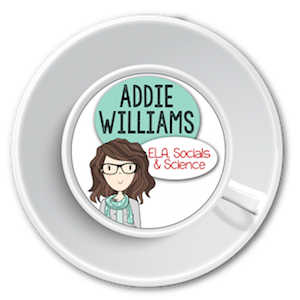One of my favourite activities to do during a short story or novel unit is to dig deep into the characters. Who are they? What are their motivations? What are their significant character traits? What is their role in the story?
Here are five fun ways to explore the types of characters and characterization in a novel or short story!
1. Start With a Video Clip
Cartoon clips or a movie can be a fun way to start off a unit on characterization. If you have the time, a great film to watch is "The Breakfast Club" - it's a great way to talk about stereotypes, and each of the main characters provides plenty of content for a character analysis.
Old vintage cartoon clips can be fun too - check out "Tom & Jerry" and have students compare and contrast the two characters. What are their defining characteristics? How do they learn about each character?
Brainstorm as a class the character traits of the cast of Sesame Street. What words would they use to describe Oscar the Grouch, Cookie Monster, Big Bird... how are these characters developed? Or you could use the characters from The Simpsons.
Pixar movie shorts are also fantastic - analyze the old man in Geri's Game or compare and contrast the mentor and the student in Lifted.
2. Whose Shoes Are These?
I like to use pairs of shoes as a starting point for students to develop a character. You can use images you collect from an internet search, or if you are really feeling ambitious, you can gather some shoes from home or from colleagues. Search for a selection of shoes to represent people of all ages and walks of life. A shoe from a child, a sneaker, a fancy shoe, a well-worn shoe... the more varied and eclectic, the better! Post the pictures or display the shoes and then have students pick a pair to analyze.
Ask students to create the character that the shoe belongs to - here are a few questions you could use to get started.
- What's your character's name? How old are they? Where were they born? Where do they live?
- What do they look like? What is important to them in terms of their appearance?
- What is their occupation? Are they married? Do they have children?
- What is their favorite food? Hobby? Sports? Skills?
- What is their greatest fear? Their greatest love? Biggest regret? Future dreams?
- What would they change about their life if they could?
- Introvert or extrovert? Pessimist or optimist?
- Best quality? Worst quality? Pet peeves?
- Who do they love? What is important to them?
- What do other people think of them? How do they relate to others?
- What are five words others would use to describe them?
3. Teaching Students to S.T.E.A.L
While reading a novel, I often ask students to pick a character to analyze and really explore as we read. Using the acronym S.T.E.A.L, students look for what the character SAYS, what they THINK, their EFFECT on others, their ACTIONS, and their LOOKS. It's an easy way to keep track of the ways we learn about characters. Grab a FREE copy of this S.T.E.A.L Reference Page and Graphic Organizer to help your students with a character analysis.
4. Character Analysis & Character Study
For a more detailed and longer look at a character, why not complete a full CHARACTER ANALYSIS OR CHARACTER STUDY? Using this set of graphic organizers and templates, students will critically look at a specific character while reading a short story or novel. As they read the novel, they will apply the elements of STEAL to help figure out the character's main personality traits. The resource includes organizers to help your students write a paragraph or a full essay - click HERE to check out my comprehensive resource!
5. Creative Character Creations
Have your students create something to represent a character in a short story or a novel. Here are just a few of the fun activities I have seen done:
- Create a character t-shirt - what color would it be? what would it look like? why?
- Create a character playlist - what five songs represent this character? explain why?
- What would the character's Instagram / TikTok / Snapchat account look like?
- Become the character and be interviewed by a classmate
- Write a bio-poem in character
For more ways to teach characterization, check out these resources from my friends in the
Secondary English Coffee Shop!
Secondary English Coffee Shop!
Digital Character Analysis for Any Text - The Daring English Teacher
Happy Birthday! Character Analysis - The Classroom Sparrow
Character Arcs, Archetypes, and Journeys - Room 213
Character Analysis & Powerpoint for Interactive Notebooks - Nouvelle ELA
Happy Teaching!


















